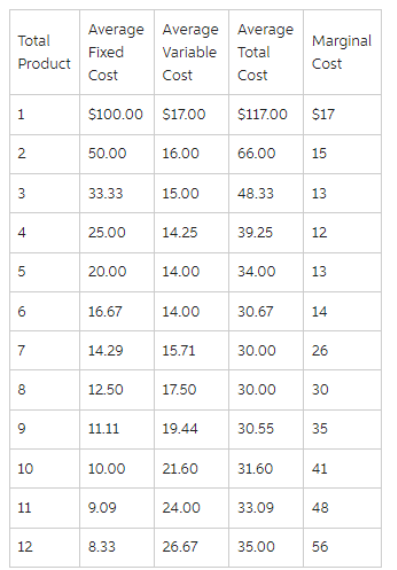A) all industries that produce standardized products.
B) any industry in which there is no nonprice competition.
C) a pure monopoly only.
D) those markets that are not purely competitive.
Correct Answer

verified
Correct Answer
verified
Multiple Choice
Economists would describe the U.S.automobile industry as
A) purely competitive.
B) an oligopoly.
C) monopolistically competitive.
D) a pure monopoly.
Correct Answer

verified
Correct Answer
verified
Multiple Choice
If a purely competitive firm is producing at the P = MC output and realizing an economic profit, at that output
A) marginal revenue is less than price.
B) marginal revenue exceeds ATC.
C) ATC is being minimized.
D) total revenue equals total cost.
Correct Answer

verified
Correct Answer
verified
Multiple Choice
The total revenue of a purely competitive firm from selling 6 units of output is $48.Based on this information, the unit price of the output must be
A) $8.
B) $42.
C) $288.
D) $54.
Correct Answer

verified
Correct Answer
verified
Multiple Choice
 The accompanying table gives cost data for a firm that is selling in a purely competitive market.If the market price for the firm's product is $12, the competitive firm should produce
The accompanying table gives cost data for a firm that is selling in a purely competitive market.If the market price for the firm's product is $12, the competitive firm should produce
A) 4 units at a loss of $109.
B) 4 units at an economic profit of $31.75.
C) 8 units at a loss of $48.80.
D) zero units at a loss of $100.
Correct Answer

verified
Correct Answer
verified
Multiple Choice
The demand curve faced by a purely competitive firm
A) has unitary elasticity.
B) yields constant total revenues even when price changes.
C) is identical to the market demand curve.
D) is the same as its marginal revenue curve.
Correct Answer

verified
Correct Answer
verified
Multiple Choice
Mutual interdependence would tend to limit control over price in which market model?
A) monopolistic competition
B) pure competition
C) pure monopoly
D) oligopoly
Correct Answer

verified
Correct Answer
verified
Multiple Choice
In contrast to American firms, Japanese firms frequently make lifetime employment commitments to their workers and agree not to lay them off when product demand is weak.Other things being equal, we would expect Japanese firms to
A) face more elastic product demand curves than American firms.
B) have relatively greater variable costs than American firms.
C) discontinue production at higher product prices than would American firms.
D) continue to produce in the short run at lower prices than would American firms.
Correct Answer

verified
Correct Answer
verified
True/False
As long as an additional unit of output yields a marginal revenue larger than its marginal cost, it will be adding to total profits of the firm.
Correct Answer

verified
Correct Answer
verified
Multiple Choice
Firms seek to maximize
A) per unit profit.
B) total revenue.
C) total profit.
D) market share.
Correct Answer

verified
Correct Answer
verified
Multiple Choice
Which of the following is not a basic market model?
A) pure competition
B) free enterprise
C) oligopoly
D) monopoly
Correct Answer

verified
Correct Answer
verified
True/False
A competitive firm will produce in the short run so long as its price exceeds its average fixed cost.
Correct Answer

verified
Correct Answer
verified
Multiple Choice
In which market model are the conditions of entry the most difficult?
A) monopolistic competition
B) pure competition
C) pure monopoly
D) oligopoly
Correct Answer

verified
Correct Answer
verified
Multiple Choice
If a purely competitive firm is producing at some output level less than the profit-maximizing output, then
A) price is necessarily greater than average total cost.
B) fixed costs are large relative to variable costs.
C) price exceeds marginal revenue.
D) marginal revenue exceeds marginal cost.
Correct Answer

verified
Correct Answer
verified
Multiple Choice
An industry comprising 40 firms, none of which has more than 3 percent of the total market for a differentiated product, is an example of
A) monopolistic competition.
B) oligopoly.
C) pure monopoly.
D) pure competition.
Correct Answer

verified
Correct Answer
verified
True/False
If the firm produces an output level below its break-even point, then the firm will earn negative economic profits.
Correct Answer

verified
Correct Answer
verified
Multiple Choice
If a purely competitive firm shuts down in the short run,
A) its loss will be zero.
B) it will realize a loss equal to its total variable costs.
C) it will realize a loss equal to its total fixed costs.
D) it will realize a loss equal to its explicit costs.
Correct Answer

verified
Correct Answer
verified
Multiple Choice
Which of the following is a reason why individual firms under pure competition would not find it gainful to advertise their product?
A) Firms produce a homogeneous product.
B) The quantity of the product demanded is very large.
C) The market demand curve cannot be increased.
D) Firms do not make long-run profits.
Correct Answer

verified
Correct Answer
verified
Multiple Choice
In which market model are the conditions of entry into the market easiest?
A) pure competition
B) pure monopoly
C) monopolistic competition
D) oligopoly
Correct Answer

verified
Correct Answer
verified
Multiple Choice
In the short run, a purely competitive seller will shut down if
A) it cannot produce at an economic profit.
B) price is less than average variable cost at all outputs.
C) price is less than average fixed cost at all outputs.
D) there is no point at which marginal revenue and marginal cost are equal.
Correct Answer

verified
Correct Answer
verified
Showing 121 - 140 of 160
Related Exams